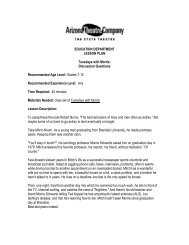Technical Theatre Unit - Arizona Theatre Company
Technical Theatre Unit - Arizona Theatre Company
Technical Theatre Unit - Arizona Theatre Company
You also want an ePaper? Increase the reach of your titles
YUMPU automatically turns print PDFs into web optimized ePapers that Google loves.
them what their unit assignment will be: taking a floor plan of a play of their choice from conception<br />
to a three-dimensional model. Tell them that by the next class period they should have several<br />
plays that they are interested in doing.<br />
Day 2: Look through all the plays the students are considering. Try to allow all the students to do<br />
their first choice but make sure no two students are doing the same play. After looking through and<br />
assigning the plays to the students explain what a rough floor plan drawing is and how to make one.<br />
If you can find any of your own rough drawings then you can show them as examples. Explain how<br />
many acting scripts include the original Broadway floor plans which can help in the conception of<br />
their own plans. The students' assignment is to create a rough drawing of a floor plan for their play<br />
by the next class period.<br />
Day 3: To begin the class period look at all the rough floor plans and give comments on what you<br />
think would and would not work. After examining the floor plan display and demonstrate how to use<br />
the different drafting tools that they will be using for their renderings: T-square, triangular scale, 30-<br />
60 and 45-90 triangles, compass, erasing shield, and templates. Next, you should explain how to<br />
make a scale rendering of the floor plan. To begin the explanation you should show them a floor<br />
plan of the stage they will be designing for and give them the height dimensions as well as the<br />
location of all the battens. The assignment for the students is to make another rough floor plan<br />
taking into account your comments, the given dimensions, and possible dimensions of their set<br />
pieces and indicating them on the drawing.<br />
Day 4: At the beginning of this class you should re-examine the rough drawings and offer any final<br />
comments. The next thing you should do is demonstrate how to transfer the rough drawing to a<br />
scale drawing using the drafting tools. To do this you could use your own production if you are<br />
doing the project with them or you could show them a finished floor plan that you have done in the<br />
past along with the rough floor plan if you still have it. The students assignment for the next class is<br />
to begin their scale renderings which they should have at least two to three class periods to work<br />
on. Some of the things you should include in your instructions are how to indicate heights of<br />
platforms, steps, and ramps as well as showing how to draw doors and windows on the floor plan.<br />
Day 5: On this day you should let the student work more on their floor plans and just walk around<br />
and answer any questions as well as offer suggestions.<br />
Day 6: The first part of this period should be spent reviewing all the terms learned thus far. After<br />
reviewing, the remainder of the period should be reserved for further work on their renderings.<br />
Day 7: By this time the students should be almost done with their floor plans and can also be<br />
tested over the terms they have learned. There are a couple possible vocabulary tests at the back<br />
of this plan which could be used. After the test the students should work on finishing their<br />
renderings.<br />
Day 8: This period should be spent discussing how to make the final step in the process. The<br />
transfer of the two-dimensional rendering to a three-dimensional model. All the students should be<br />
given something (a board or piece of stiff cardboard) in the size and shape of the stage which they<br />
designed their floor plans for to build their model on. The major part of the period should be spent


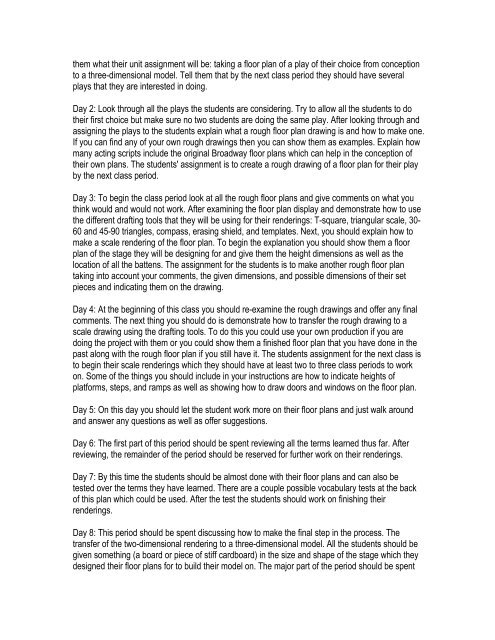
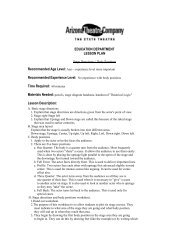



![Play Guide [356k PDF] - Arizona Theatre Company](https://img.yumpu.com/46218320/1/190x245/play-guide-356k-pdf-arizona-theatre-company.jpg?quality=85)
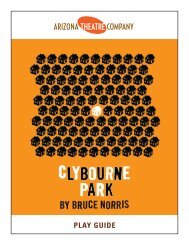
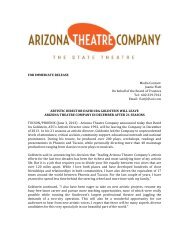
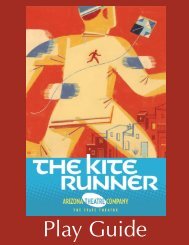

![[title of show] Arizona Theatre Company Play Guide 1](https://img.yumpu.com/24482689/1/190x245/title-of-show-arizona-theatre-company-play-guide-1.jpg?quality=85)
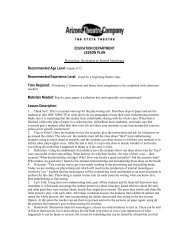
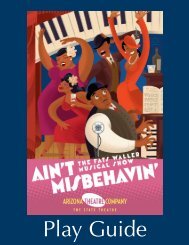
![Play Guide [1.2MB PDF] - Arizona Theatre Company](https://img.yumpu.com/11952176/1/190x245/play-guide-12mb-pdf-arizona-theatre-company.jpg?quality=85)
